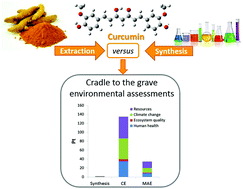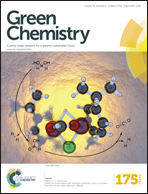Phytochemical compounds or their synthetic counterparts? A detailed comparison of the quantitative environmental assessment for the synthesis and extraction of curcumin†
Abstract
Natural compounds represent an extremely wide category to be exploited, in order to develop new pharmaceutical strategies. In this framework, the number of in vitro, in vivo and clinical trials investigating the therapeutic potential of curcumin is exponentially increasing, due to its antioxidant, anti-inflammatory and anticancer properties. The possibility to obtain this molecule by both chemical synthesis and extraction from natural sources makes the environmental assessments of these alternative production processes of paramount importance from a green chemistry perspective, with the aim, for both industries and academia, to pursue a more sustainable development. The present work reports detailed and quantitative environmental assessments of three different curcumin production strategies: synthesis, conventional Soxhlet-based extraction (CE) and microwave-assisted extraction (MAE). The chemical synthesis of curcumin, as recently optimized by the authors, has been firstly evaluated by using the EATOS software followed by a complete “cradle to the grave” study, realized by applying the Life Cycle Assessment (LCA) methodology. The life cycles of CE and MAE were then similarly assessed, considering also the cultivation of Curcuma longa L., the production of the dried rhizomes as well as their commercialization, in order to firstly investigate the widely claimed green character of MAE with respect to more conventional extraction procedures. Secondly, the results related to the two different extraction strategies were compared to those obtained by the chemical synthesis of curcumin, with the aim to determine its greenest preparation procedure among those investigated. This work represents the first example of an environmental assessment comparison between different production strategies of curcumin, thus smoothing the way towards the highly desirable establishment of environmentally friendly rankings, comprising all the existing alternatives to the chemical synthesis of a target chemical compound.

- This article is part of the themed collection: 3rd International Symposium on Green Chemistry

 Please wait while we load your content...
Please wait while we load your content...